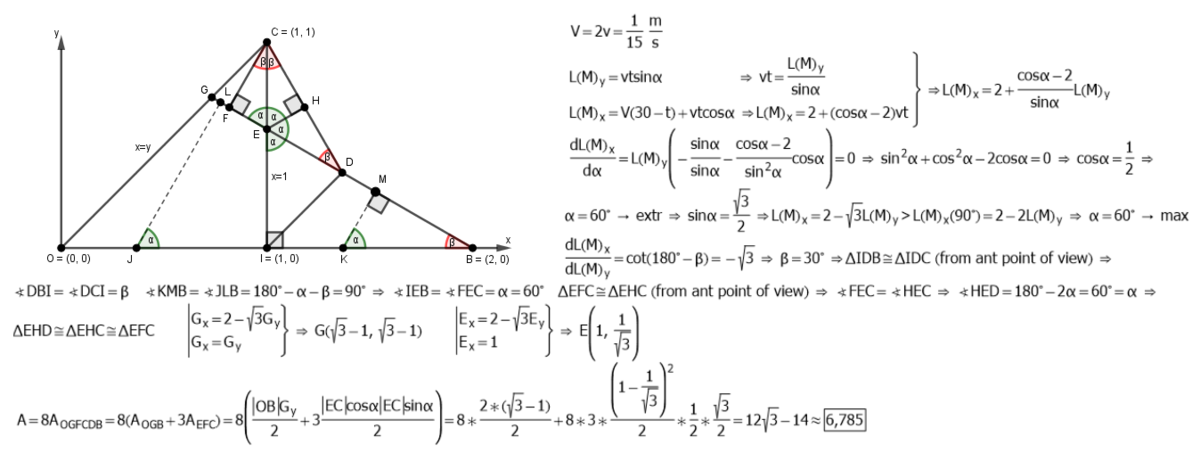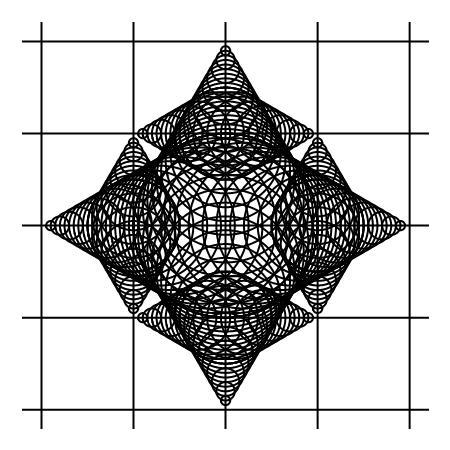Ant highway

Imagine the square grid is a network of narrow ant highways spaced 1 m e t e r apart.
An ant can walk 1 m e t e r in 1 5 s e c o n d s along these roads. However, if an ant strays off of a highway and into the dirt, it can only travel half as fast.
The four colored paths lead to points an ant can reach in 3 0 s e c o n d s .
Find the area in m 2 of the region composed of all points an ant can reach in at most 3 0 s e c o n d s .
Hint: the optimum direction for heading off the highway is 6 0 d e g r e e s .
The answer is 6.784609691.
This section requires Javascript.
You are seeing this because something didn't load right. We suggest you, (a) try
refreshing the page, (b) enabling javascript if it is disabled on your browser and,
finally, (c)
loading the
non-javascript version of this page
. We're sorry about the hassle.
3 solutions

This image is the set of all points an ant can reach in 30 seconds. It has enough symmetry that we can analyze half of one quadrant and multiply the resulting area by 8.

Beginning with △ A B C we have A B = 1 = h + h 3 so h = 2 3 − 1 and the entire light and dark green region has area 2 3 − 1
For the red, orange and yellow regions it will help to coordinatize. D = ( 0 , 0 ) , A = ( 1 , 0 ) , B = ( 2 , 0 ) , I = ( 1 , 1 )
The line containing D I is y = x . The line containing H I is y = 3 x + 1 − 3 . The line containing G H and also B C is y = 3 − 3 x + 3 2 3
From which we can solve for the points of intersection. G = ( 3 − 1 , 3 − 1 ) and H = ( 4 5 − 3 , 4 1 + 3
The area of △ D E G = 2 1 ( 3 − 1 ) ( 3 − 1 ) = 2 − 3
The area of trapezoid E F H G = 2 1 ( 4 5 − 3 − ( 3 − 1 ) ) ( 4 3 − 1 + 3 − 1 ) = 1 6 1 ( − 5 1 + 3 0 3 )
The area of trapezoid F A I H = 2 1 ( 1 − 4 5 − 3 ) ( 1 + 4 1 + 3 ) = 1 6 1 ( 2 3 − 1 )
Sum the four areas and multiply the result by 8 gives the final answer 1 2 3 − 1 4 ≈ 6 . 7 8 4 6 0 9 6 9 1

I just find the relevant equations of the lines in the positive (x-y) quadrants, whose intersections determine the areas in three squares along x and y axis. In the square (1) the lines are, x/(2/√3)+y/2=1, y=x, 3y-√3x=(3-√3), and symmetry along line (y=x). The area = {(5/√3)-2} + {(1/√3)-(1/2)}= 0.964101, while in other two squares (2) additional line is y=x+1 symmetry line and area= {1/(1+√3)}= 0.366025 and (3) same as in (2) with area= {1/(1+√3)}=0.366025. Thus in the (x-y) quadrant area=1.696151 and total area in all four quadrants gives Answer=4*1.696151=6.7846.
